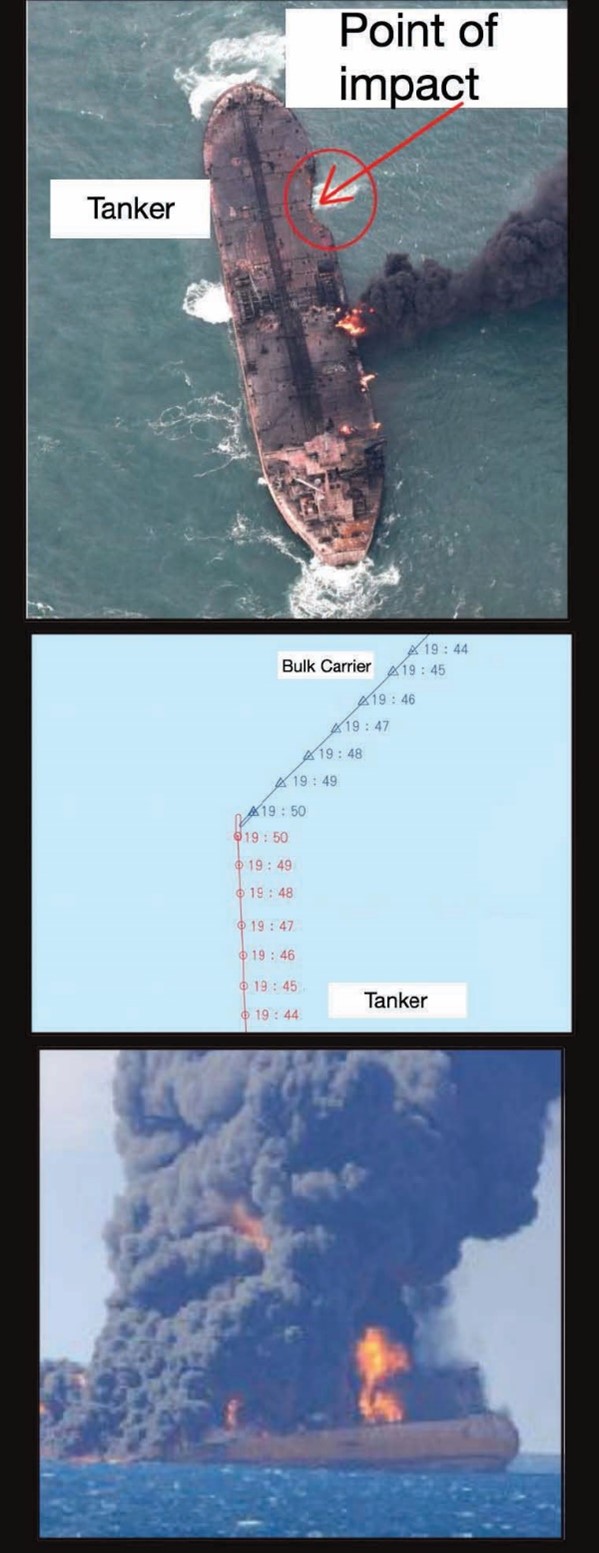As a give way vessel, you need to take ‘early and substantial action’ says The Nautical Institute in its latest Mars Report. This report shows just how badly things can go wrong when action isn’t taken: A collision between a tanker and bulk carrier resulted in 32 fatalities.
The Nautical Institute gathers reports of maritime accidents and near-misses. It then publishes these so-called Mars Reports (anonymously) to prevent other accidents from happening. A summary of this incident:
A tanker loaded with condensate oil was underway in darkness and good visibility at about 10 knots. It was sailing in a coastal area with many fishing vessels in the vicinity.
The officer of the watch (OOW) was assessing the various radar targets for collision avoidance. A target was plotted on their starboard side, bearing 022 degrees and at about 5.5 nm, and the OOW and lookout discussed the fact that the bow crossing distance was near zero. Shortly after this conversation, a nearby fishing boat, also on their starboard side and on a near collision course, attempted to contact the tanker.
The OOW on the tanker can be heard to comment to the lookout: ‘Oh, he’s talking to another one. You know, never answer these calls. Because if you don’t answer, it is not ok to action. But if you answer, he seems … he confirms with you about his action. So he takes action, whatever he said in the radio and you don’t understand. But if you don’t answer, he shall be forced to take action to make himself clear, understand?’
When the fishing vessel was about 2 nm away, the OOW on the tanker asked the lookout to signal the fishing boat with the ALDIS lamp. In the following minutes, the OOW saw the fishing boat altering course to port to pass astern of their vessel. Now, he turned his attention to the other target, a bulk carrier on their starboard side making about 13 knots, and asked the lookout to signal it with the ALDIS lamp, five flashes to attract attention.
Also read: Dutch Safety Board launches investigation into water taxi and ferry collision
At this time, the OOW can be heard to remark to the lookout: ‘We should take action. But what action can I take in this situation? Starboard side is full.
About this time, there was a change of watch on the bulk carrier. The new OOW saw the tanker on AIS, but assumed it was a fishing vessel. Apparently, the tanker did not present a radar target and it appears the bridge team on the bulker did not visually sight it.
As the distance between the two vessels decreased, the OOW of the tanker called the master to inform him of the dangerous situation. At the last minute, the OOW on the tanker ordered hard starboard helm just as the master entered the bridge. The helm action was too late to avoid collision and the bulk carrier’s bow hit the tanker’s starboard side. The resulting damage caused leakage of the condensate oil cargo, which quickly caught fire and caused various explosions. Within minutes the vessel, including the bridge, was engulfed in flames.
All 32 crew on board the tanker were declared deceased or missing and the hull eventually sank. The bulk carrier sustained extensive structural damage to the bow and burn damage to other areas. The crew abandoned ship and were rescued by a fishing vessel.[3] Within minutes of the collision, the vessel, including the bridge, was engulfed in flames.

Also read: Allianz: ‘Fire, collision, sinking and damaged cargo top causes of marine insurance losses’
Investigation findings
The official investigation found, among other things that:
- Neither vessel’s OOW complied with the collision regulations. The tanker, as the give way vessel, should have taken early and substantial action to avoid collision. The bulk carrier, as the stand on vessel, should have taken action when it became apparent that without their action a collision was inevitable.
- Although the OOW of the bulk carrier had noticed the tanker on AIS, he assumed it was a fishing vessel and he did not confirm with a visual sighting.
Also read: How Dutch coaster Helge was salvaged after collision and crew evacuation
Advice from The Nautical Institute
- Early and substantial action was required by the tanker as the give way vessel. The OOW seems to have thought that a course alteration (to starboard) was the only option and, as his starboard side had other vessels present, he did nothing. Had he reduced speed in good order, this would have allowed both the fishing vessel and the bulk carrier to pass ahead.
- Given a vessel on your starboard side with a zero CPA, do not assume that just because it is a fishing vessel, it will alter course to avoid your vessel. Fishing vessels have the same rights and obligations as large cargo vessels.
- Using an ALDIS lamp to attract the attention of an oncoming vessel may be part of the solution during a close quarters situation. But, as a give way vessel, using the ALDIS lamp to warn other vessels of your presence, instead of taking the required action as required by the collision regulations, would appear to fly in the face of those rules.
Also read: What collisions between commercial and small vessels can teach us
Mars Reports
This accident was covered in the Mars Reports, originally published as Mars 202320, that are part of Report Number 366. A selection of this Mars Report was also published in SWZ|Maritime’s May 2023 issue. The Nautical Institute compiles these reports to help prevent maritime accidents. That is why they are also published (in full) on SWZ|Maritime’s website.
More reports are needed to keep the scheme interesting and informative. All reports are read only by the Mars coordinator and are treated in the strictest confidence. To submit a report, please use the Mars report form.







